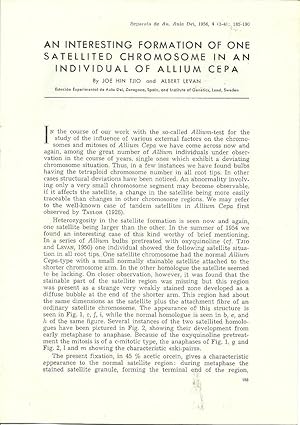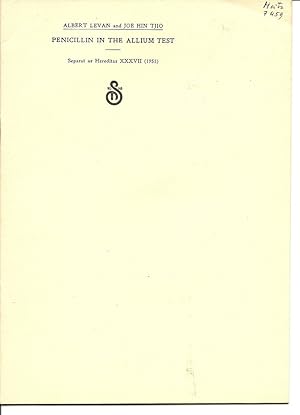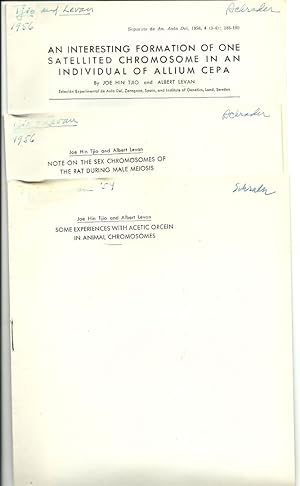Tjio, Joe Hin; Levan, Albert (5 results)
Product Type
- All Product Types
- Books (5)
- Magazines & Periodicals
- Comics
- Sheet Music
- Art, Prints & Posters
- Photographs
- Maps
-
Manuscripts &
Paper Collectibles
Condition
- All Conditions
- New
- Used
Binding
- All Bindings
- Hardcover
- Softcover (1)
Collectible Attributes
- First Edition (1)
- Signed
- Dust Jacket
- Seller-Supplied Images
- Not Printed On Demand
Seller Location
Seller Rating
-
An Interesting Formation of One Satellited Chromosome in an Individual of Allium Cepa by Tjio, Joe Hin; Levan, Albert
Published by Estacion Experimental de Aula Dei, Zaragoza, Spain, 1956, 1956
Pamphlet. Condition: Collectible; Very Good. Prompt shipment, with tracking. we ship in CLEAN SECURE BOXES NEW BOXES Separata de An. Aula Dei, 1956, 4 (3-4) 185-190. First edition. Offprint. Very good. Science. Genetics. Biology. *Summary: [EN] A case of heterozygous development of the satellited chromosome pair of Allium Cepa is described. One of the homologues had a satellite, while the other one had a satellite zone of normal size, but devoid of stainable satellite granule (Fig. 1,2). Division of the satellite granule in preparation of the next nitosis was observed in anaphase chromosomes (Fig. 3) "Joe Hin Tjio (1919?2001), was a cytogeneticist renowned as the first person to recognize the normal number of human chromosomes. This epochal event occurred on December 22, 1955 at the Institute of Genetics of the University of Lund in Sweden, where Tjio was a visiting scientist." Wikipedia.
-
Penicillin in the Allium Test by Levan, Albert and Joe Hin Tjio
Published by Hereditas XXXVII, 1951, 1951
Condition: Very Good. Prompt shipment, with tracking. we ship in CLEAN SECURE BOXES NEW BOXES Tip bumped, name in ink front cover else very good. Hereditas, v37 n3 (June 1951): 306-324. "Joe Hin Tjio (1919-2001), was a cytogeneticist renowned as the first person to recognize the normal number of human chromosomes. This epochal event occurred on December 22, 1955 at the Institute of Genetics of the University of Lund in Sweden, where Tjio was a visiting scientist." Wikipedia. *.
-
4 scarce offprints by Jo Hin Tjio: Some Experiences with Acetic Orcein in Animal Chromosomes and 2 others by Tjio, Joe Hin; Albert Levan one with Arne Hagberg
Published by Anales De La Estacion Experimental De Aula Del, 1954, 1956, 1956
Pamphlet. Condition: Collectible; Good. Prompt shipment, with tracking. we ship in CLEAN SECURE BOXES NEW BOXES The titles included: Cytological Studies on Some X-Ray Mutants of Barley (1951) with Arne Hagberg, some wear and tearing to spine (not scanned); Some Experiences with Acetic Orcein in Animal Chromosomes with Albert Levan (1954); Note on the Sex Chromosomes of the Rat During Male Meiosis with Albert Levan (1956); An Interesting Formation of One Satellited Chromosome in an Individual of Allium Cepa with Albert Levan (1956). Three scarce offprints have the ownership signature of Franz "Schrader" in ink, other has stamp of J. T. Baldwin Jr. Upper left hand cover of the front pages of three have light dampstain affecting name and date of authors, but are not affecting text. Still a scarce grouping of the discoverer of the Numbers of Chromosomes in man. Condition presents a discount in what would be our normal pricing for such offprints. * Genetics. Chromosomes. Cytology.
-
Chromosome Analysis of Three Hyperdiploid Ascites Tumours of the Mouse by Tjio, Joe Hin and Levan, Albert
Published by Lund C.W.K. Gleerup, 1954, 1954
Condition: Very Good. Prompt shipment, with tracking. we ship in CLEAN SECURE BOXES NEW BOXES Lunds Universitets Arsskrift, Vol. 50, No. 15, pp. 1-38. Very good condition.* Some nicks and sunning to edges. Johannes Holtfreter signature of ownership front cover. Compliments of Joe Hin Tjio card laid in. Genetics.
-
Lund, 1956. 4to. Minor signs of wear. A fine copy, With signature of "Joh. Holtfreter" to top of p. (1). 6 pp. + 1 plate. First printing, in the very rare off-print - Johannes Holtfreter's copy -, of the revolutionary paper that established for the first time the correct number of chromosomes in man, thus founding modern human cytogenetics. The present paper constitutes the most important breakthrough in genetics since Mendel. "The finding that the normal human diploid chromosome number was 46, rather than 48 as had been assumed for many years previously, represents the starting point of modern human cytogenetics, with great importance for future clinical applications in the detection of both constitutional chromosome abnormalities and somatic abnormalities such as those seen in cancers. This discovery, made 50 years ago at the Institute of Genetics of the University of Lund, Sweden, in December 1955 and published early in 1956 in the journal "Hereditas" (Tjio and Levan 1956), is now of historical as well as scientific importance." (Harper). "After 50 years, the paper of Tjio and Levan can be clearly seen as one of the major landmarks of human genetics, opening up the field of human chromosomes and of medical genetics generlly to detailed analysis, as well as fulfilling its original aim of providing a normal reference point for studies of chromosomes in cancer." (Harper).The rediscovery of Mendel's law at the end of the 19th century triggered intense interest in the principles of heredity" ever since that time, chromosome behavior had been studied scientifically, but although a great deal of scientific interest was directed towards learning more about chromosomes themselves, it wasn't until Joe Hin Tjio and Albert Levan's epochal discovery that the correct human chromosome count was established. For half a century it had been accepted that humans normally have 48 chromosomes - only due to Tjio and Levan were we to know that the chromosome number of man is actually 46. "Difficulties in determining the human diploid number arose for a variety of reasons. For one, early experiments that provided evidence for the chromosome theory often used invertebrate species that reproduced in large numbers and had a relatively low number of well-defined chromosomes. Neither of these characteristics, of course, is a common finding in humans. In addition, the human samples initially used for chromosome analysis were derived from fresh testicular tissue in which haploid meiotic cells were often present. Furthermore, what morphology could be deduced suggested that human chromosomes were more complex than those of the model organisms studied earlier. In light of these and other factors, an erroneous estimate by prominent cytologist Theophilus Painter dominated the field for decades, until researchers Joe Hin Tjio and Albert Levan eventually applied new technology to identify the true diploid number of human chromosomes." (O'Connor). As Painter's estimate of 48 chromosomes had been generally accepted from studies over the previous 30 years, study of normal human chromosomes was not an active research field in the mid-1950's. Albert Levan - one of the key figures in cancer cytogenetics -, however, extensively studied the chromosomes of human cancers and realized that it was necessary to be certain of the normal human karyotype. Likewise, Joe Hin Tjio - who then was primarily involved in plant cytogenetics - realized the importance and necessity in establishing the correct number. "In the decades following Painter's work, scientists continued to refine their methods for preparing chromosomes for microscopy. Sectioning of paraffin-embedded preserved tissue was gradually replaced by squash techniques, in which small tissue specimens are placed on a microscope slide and then literally squashed under a cover slip to produce a single layer of cells. This approach gained broad acceptance as it eliminated any need to slice through tissues and reconstruct the organization of chromosomes in a single nucleus from several different sections. Chromosome preparations were also dramatically improved by combining treatment with a hypotonic salt solution (described by T. C. Hsu in 1952) and cell fixation. This combination of treatments enhanced chromosome spreading without deterioration or fragmentation, thereby facilitating better chromosome counts. In fact, in 1956, these techniques enabled researchers Joe Hin Tjio and Albert Levan to make a more accurate estimate of the human chromosome number.When their classic paper was published in 1956, Tjio and Levan had already been collaborating for several years. Albert Levan was a well-established cytologist who had pioneered the use of colchicine for analyzing chromosomes. Colchicine is a plant-derived toxin that arrests cells in metaphase, the point in the cell cycle at which chromosomes are most condensed. Colchicine is toxic to animals, but Levan and others found that colchicine allowed investigators to work with cells grown in tissue culture. Capturing cells at a specific state of mitosis when the chromosomes are condensed and easily tracked improved the reliability of their observations. Tjio and Levan used spreads such as these in their research, eventually reporting summary data from 261 unique chromosome spreads obtained from 22 different cell cultures of fetal lung tissue. All of the cultures were used within a few days after the tissue was obtained, thus minimizing the possibility of long-term culture-induced artifacts of chromosome number. The results were both clear and replicable. In the words of Tjio and Levan, "We were surprised to find that the chromosome number 46 predominated in the tissue cultures from all four embryos, [with] only single cases deviating from this number." Appreciating the fact that these in vitro data may not have been representative of cells in the body (i.e., in vivo data), Tjio and Levan also highlighted the importance of finding the same ch.






![Seller image for The Chromosome Number in Man. Separat (=Offprint) ur Hereditas 42 (1956). - [ESTABLISHING THE NORMAL NUMBER OF CHROMOSOMES IN MAN - FOUNDING CYTOGENETICS] for sale by Lynge & Søn ILAB-ABF](https://pictures.abebooks.com/inventory/md/md22188964686.jpg)